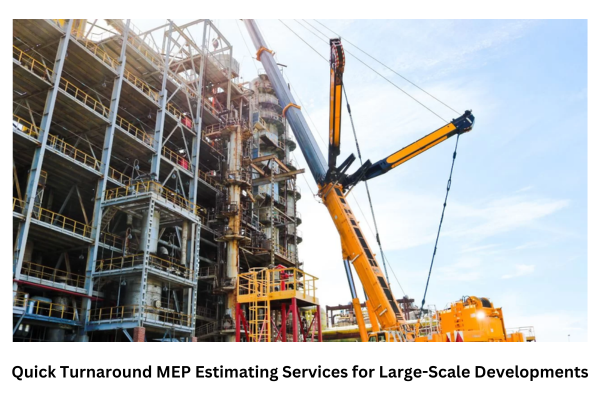Quick Turnaround MEP Estimating Services for Large-Scale Developments

In the fast-paced world of large-scale commercial and industrial construction, timely and accurate cost estimates are crucial for project success. Mechanical, Electrical, and Plumbing (MEP) systems form the backbone of any development, and precise MEP estimating ensures efficient budgeting, effective planning, and minimal disruptions during construction. However, many projects require rapid estimations to stay on schedule or to meet unexpected deadlines. Offering quick turnaround MEP estimating services is not only a valuable capability but also a competitive advantage for precision estimators in today’s market.
This article explores the importance of quick turnaround MEP estimating, the challenges it presents, and effective strategies for delivering reliable estimates under tight timelines, all while maintaining the accuracy needed for large-scale developments.
1. Why Quick Turnaround MEP Estimating Matters for Large-Scale Developments
For large-scale projects, the importance of timely MEP estimating cannot be overstated. Developers, contractors, and project managers rely on quick yet accurate MEP estimates to:
- Maintain Project Timelines: Many large developments operate on strict schedules, where any delay in the estimating phase can cascade into setbacks for the entire project.
- Secure Project Funding: Investors and stakeholders require accurate budget forecasts early in the project lifecycle, and delays in estimates can impede funding approval.
- Prevent Cost Overruns: Quick estimates allow for early identification of high-cost areas or budget discrepancies, helping teams make adjustments before costs escalate.
- Stay Competitive: Construction bidding is competitive, and a quick, precise estimate can give contractors a significant edge in winning contracts.
With large-scale developments, MEP estimates must be detailed and comprehensive to cover complex systems, from HVAC and electrical distribution to plumbing and specialized controls. Achieving this level of detail on a quick turnaround requires careful planning, specialized tools, and efficient workflows.
2. Challenges of Quick Turnaround MEP Estimating
While rapid MEP estimating is essential, it presents unique challenges for precision estimators, especially for large-scale projects. Some of these challenges include:
- Complexity of MEP Systems: Large projects require extensive MEP systems that are integrated and often customized. Estimating each component within a short timeframe requires an exceptional level of organization and expertise.
- Risk of Compromised Accuracy: A rushed estimate can lead to inaccuracies, which may result in cost overruns, delays, or budget revisions down the line.
- Coordination with Multiple Stakeholders: In large developments, estimators must collaborate with engineers, architects, and project managers, which can become complicated when working within tight deadlines.
- Material Cost Fluctuations: Rapid estimates must account for current material costs, which can vary frequently. Failing to consider price trends can result in budgets that quickly become outdated.
- Labor Constraints: Accurate labor cost estimation is complex and requires up-to-date information on local labor rates and availability, which can be challenging to compile quickly.
3. Best Practices for Quick Turnaround MEP Estimating
To overcome these challenges and deliver accurate, quick-turnaround MEP estimates, precision estimators can adopt several best practices.
a. Utilize Advanced Estimating Software
Estimating software tools like Trimble, PlanSwift, and Bluebeam are invaluable for quick turnaround estimates. These platforms provide templates, cost databases, and automation features that allow estimators to quickly input project parameters and generate detailed estimates. Key advantages include:
- Automated Quantity Takeoffs: Automating the takeoff process saves time and reduces human error, particularly for complex MEP components like ductwork, piping, and electrical wiring.
- Pre-built Cost Libraries: These tools often come with cost databases that can be customized to reflect regional prices, streamlining the cost input process.
- BIM Integration: Building Information Modeling (BIM) integration allows estimators to work directly from 3D models, improving accuracy and enabling quick adjustments if the design changes.
By reducing manual processes, these software tools enable faster turnaround times without sacrificing accuracy.
b. Develop a Standardized Estimating Process
Establishing a clear, repeatable process is essential for quick turnaround estimates. Creating a standardized workflow for MEP estimating helps reduce time spent on setup and ensures consistency across projects. Key elements of a standardized process might include:
- Template Libraries: Use templates for common MEP systems in large-scale developments, such as commercial HVAC layouts or electrical distribution setups, to reduce the time required for each estimate.
- Historical Data: Maintain a library of past estimates for similar projects. Access to historical data allows for faster cost projections, as previous estimates can serve as a foundation.
- Phased Estimates: For rapid turnaround, consider delivering phased estimates, such as an initial high-level estimate followed by detailed line items. This approach allows decision-makers to proceed with preliminary budget approvals while waiting for a more granular estimate.
c. Leverage Collaboration and Communication Tools
Given the collaborative nature of MEP estimating, effective communication is essential. Using collaborative tools like Microsoft Teams, Slack, or specialized construction management software facilitates real-time communication between estimators, engineers, and project managers. Efficient collaboration leads to:
- Faster Decision-Making: With clear lines of communication, stakeholders can quickly address questions or provide additional project details.
- Reduced Rework: Ongoing communication helps to identify potential discrepancies early, minimizing the need for costly revisions.
- Streamlined Approval Processes: Collaborative tools allow for quick feedback and faster sign-off, essential when working on tight timelines.
d. Prioritize Critical Path MEP Components
For a quick estimate, focusing on the MEP components that are most critical to the project timeline and budget is essential. By prioritizing high-cost or high-impact items, such as HVAC systems, electrical distribution panels, and plumbing risers, estimators can produce a rough estimate that captures the major costs, allowing stakeholders to make initial budget decisions.
Once the primary components are covered, estimators can refine the estimate with additional details, ensuring that the essential information is available early without sacrificing overall accuracy.
e. Account for Contingencies
In quick estimates, where details may be limited, it’s wise to include contingency costs for potential fluctuations or unforeseen expenses. This buffer helps to protect against sudden changes in material prices or labor rates, reducing the risk of cost overruns.
For large-scale projects, a typical contingency may range from 5% to 10% of the total MEP estimate. However, this amount can vary based on project complexity and current market conditions.
4. The Role of a Precision Estimator in Quick Turnaround Services
Precision estimators bring a high level of expertise to quick turnaround estimating services by combining their technical knowledge with practical experience. Their role is multifaceted, involving a blend of analytical skills, time management, and problem-solving abilities. Key responsibilities for a precision estimator in this context include:
- Conducting Rapid yet Thorough Takeoffs: A precision estimator must accurately quantify materials and labor for each MEP component, even under tight deadlines.
- Making Informed Assumptions: In rapid estimations, assumptions based on past projects, industry trends, and supplier relationships play a role in shaping initial budgets.
- Maintaining Accuracy Under Pressure: While the timeline is short, a precision estimator’s primary goal remains accuracy. Their reputation depends on delivering estimates that closely align with actual costs.
- Providing Clear, Actionable Insights: Precision estimators help project teams understand the cost implications of design choices, ensuring that even quick estimates offer meaningful data.
5. Conclusion: Delivering Reliable Quick Turnaround MEP Estimating Services
Quick turnaround MEP estimating services are invaluable in today’s construction industry, enabling large-scale developments to stay on track and within budget. By leveraging advanced software, establishing standardized processes, and maintaining strong communication channels, precision estimators can provide rapid and reliable estimates that meet the demands of modern construction projects.
For precision estimators, the key to successful quick turnaround estimating is balancing speed with accuracy. This requires a combination of cutting-edge tools, clear processes, and collaboration with other project stakeholders. As the demand for fast, accurate estimates continues to grow, estimators who master these skills will be well-positioned to provide exceptional value in the highly competitive field of large-scale commercial construction.

